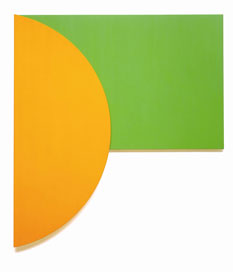Three Exhibitions
dal 27/1/2006 al 6/5/2006
Segnalato da
Ellsworth Kelly
Keiko Mukaide
J.M. William Turner
Sam Smiles
Roanne Dods
Christoph Grunenberg
27/1/2006
Three Exhibitions
Tate St Ives, St Ives (Cornwall)
Ellsworth Kelly, Keiko Mukaide, J.M. William Turner

Three Exhibitions.
Ellsworth Kelly.
Orange Relief with Green.
The American artist Ellsworth Kelly is much admired in Britain but very rarely seen. This exhibition brings together two special loans alongside a number of paintings from the Tate Collection, to create an installation in the curved sea-facing gallery relating to the architectural dynamic in Kelly's work. A select group of Plant Lithographs from the Grand Rapids Museum's touring exhibition - showing Kelly's fascination with form in nature, will also be included.
Since the late 1940s Kelly has explored the power of abstract form through meticulous geometry to create paintings and sculptures which reveal an extraordinary poetic vision. Kelly's skill in working with form, colour, space and line to create monumental visual statements is a result of his acute spatial sensibility and an understanding of the potential in the fusion of these elements. Kelly treats colour as an independent element in which representation no longer plays a role but the colour itself becomes form and utilises the architectural plane on which it sits and the space around it. Kelly is interested in the elusiveness of forms that we glimpse as part of our lives and manipulating such forms to create new illusions of space and colour.
Keiko Mukaide.
Glass Installation.
For nearly 200 years, visual artists visiting the region have been inspired by the exquisite light and atmosphere of the Cornish landscape, capturing, in paintings and sculpture, a unique spirit of place. It is the intuitive response to place which motivates the site-specific installations of glass artist Keiko Mukaide (b1954).
Born in Japan, now living and working in Fife on the Scottish coast, Mukaide's work evolves not only from an aesthetic response to the surrounding landscape, but through a greater fascination with both its histories and natural rhythms. In her new commission for the 55 foot-long, sea-facing showcase at Tate St Ives, the artist has created an installation of brilliant coloured light using shards of dichroic glass, centrally lit by a beehive light-house lens. In dialogue with the maritime heritage of both her adopted Scottish home and Cornwall’s St Ives, the work also probes ideas about human perceptions of the landscape, deriving from both a real and imaged experience. Reminiscent of Constructivist sculptor’s Naum Gabo's translucent Perspex spirals or painter Wilhelmina Barns-Grahams studies of sparkling glacial forms made in the mid-twentieth century, Mukaide uses the translucent and prismatic properties of glass as a metaphor for the unseen forces of nature, which sustain the forms and structures we physically encounter. A notion, as we are reminded by the landscapes of JMW Turner - in the adjacent galleries - which are infused with a divine light, seems inextricably bound up with our philosophical and spiritual sensibilities.
J.M. William Turner.
Light into Colour: Turner in the South West.
J.M.W. Turner's tours in the South West have never been the subject of an exhibition before. Turner toured Devon and Cornwall in 1811, returning to Devon in 1813 and 1814; what he accomplished in this region presents an exciting opportunity for Tate St Ives to bring his work to Cornwall for the first time in an exhibition curated by Turner expert Professor Sam Smiles.
The work produced in Cornwall and West Devon occurred at an important stage in Turner's development. His maturity as an observer of English topography had secured him the commission to produce a series of watercolours for engraving as Picturesque Views on the Southern Coast of England. In the summer of 1811 he travelled round the coast of the West of England, from Dorset to Somerset recording what he saw. This trip provided him not merely with images of tranquil landscape and historic buildings; it was also a place of modern occupations, ranging from quarrying, lime manufacture and fishing to large-scale naval preparations in the war against Napoleon. Turner's omnivorous gaze took stock of the interplay between contemporary life and historic environments in this region, putting the present into dialogue with the past. In doing so, he announced his arrival as a comprehensive witness of modern England. It is also arguable that the qualities of light he observed in the West Country prompted some early experiments, especially in his 1813 oil sketches, that laid the ground for his exploration of light in Italy in 1819 and afterwards.
The exhibition includes examples of Turner's work in all media (oil paintings, oil sketches, watercolours, pencil sketches and notebooks), providing spectators with a rounded exposure to his different working methods. In reuniting sketches with finished work it will be possible to enter into Turner's creative development of observed reality as it becomes a suitable subject for a finished picture.
Opening: 28 Jenuary 2006
Tate St. Ives
Porthmeor Beach - St Ives
Hours: Daily 10.00-17.30



